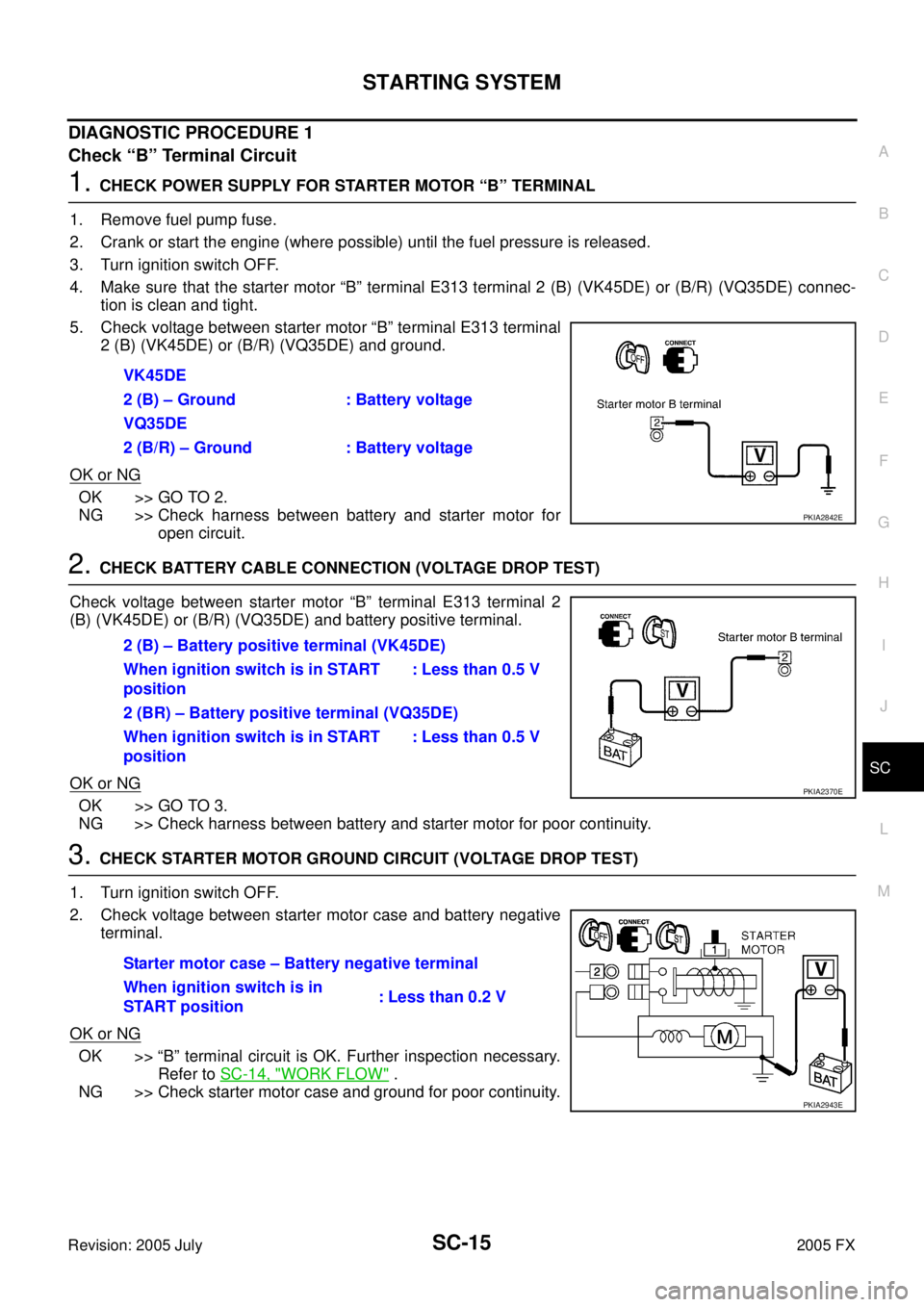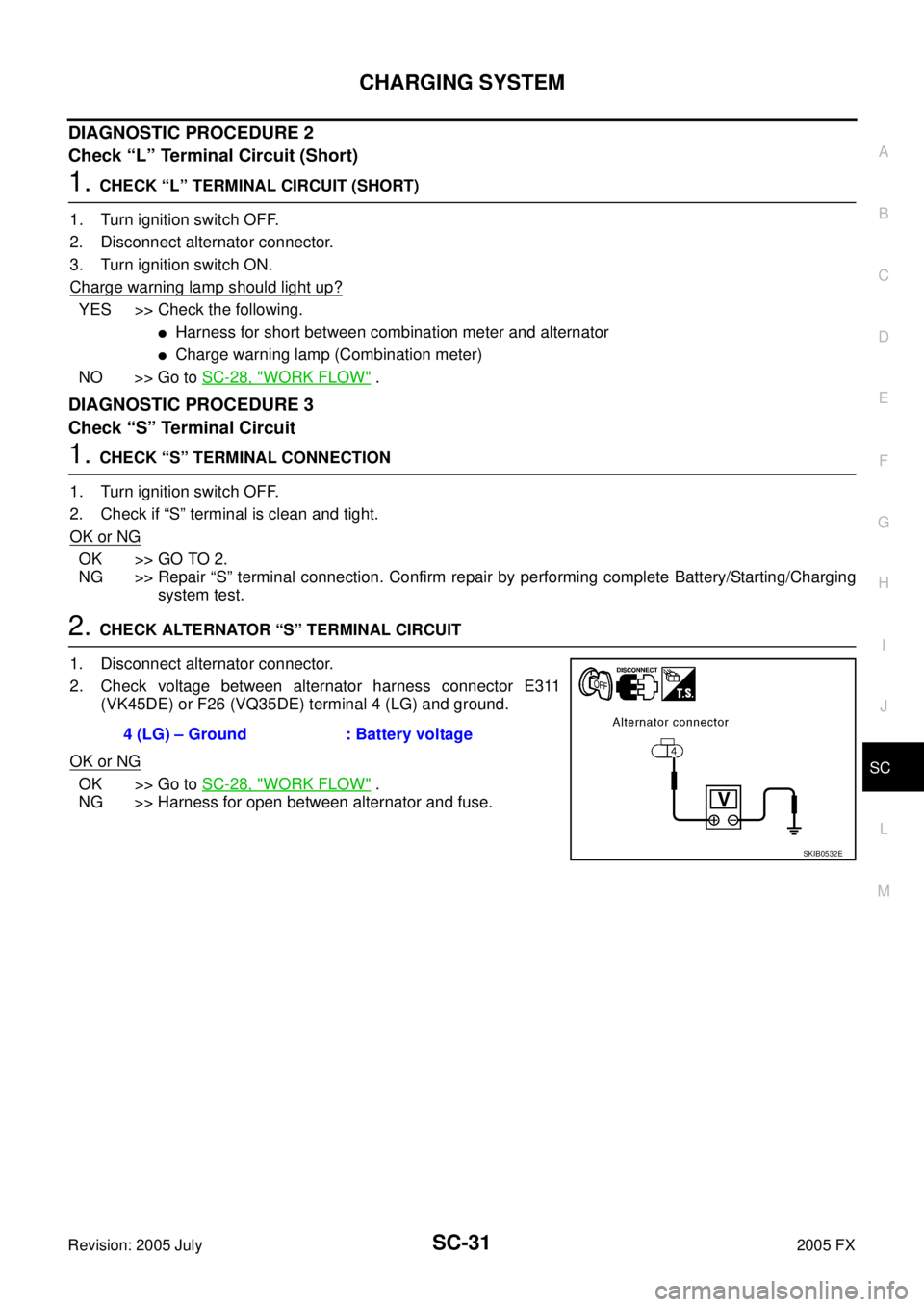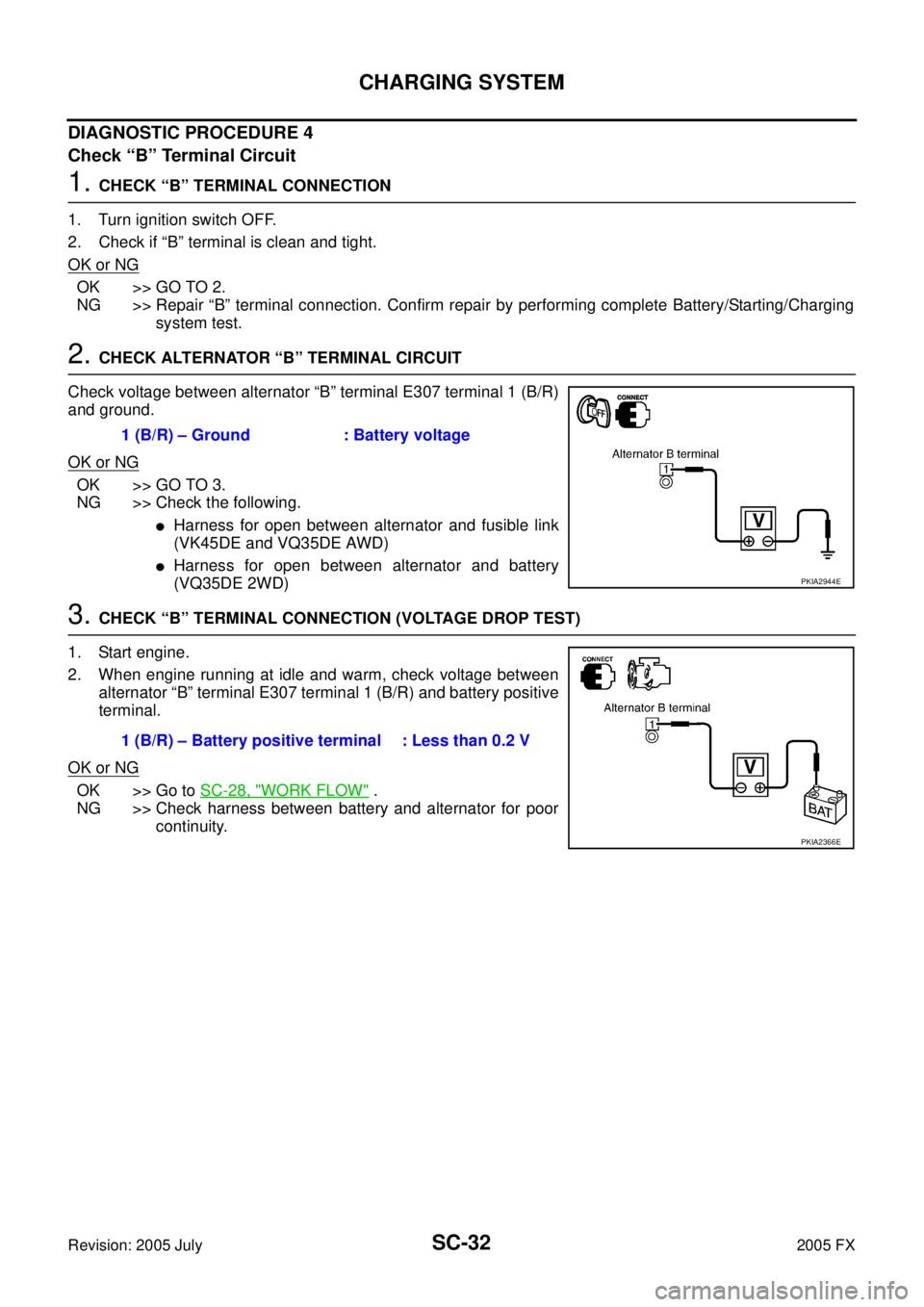Page 4445 of 4731

SC-10
STARTING SYSTEM
Revision: 2005 July 2005 FX
STARTING SYSTEMPFP:23300
System Description AKS0079C
Power is supplied at all times
�through 40A fusible link (letter F, located in the fuse and fusible link block)
�to ignition switch terminal 1,
�through 15A fuse (No. 78, located in the IPDM E/R)
�to CPU of IPDM E/R,
�through 10A fuse (No. 71, located in the IPDM E/R)
�to CPU of IPDM E/R.
When the selector lever in the P or N position, power is supplied
�from TCM, and through A/T assembly terminal 9
�to IPDM E/R terminal 53.
Ground is supplied
�to IPDM E/R terminals 38, 50 and 60
�from grounds E21, E50 and E51.
With the ignition switch in the START position, and provided that the IPDM E/R receives a starter relay ON sig-
nal from the CAN lines, the IPDM E/R is energized and power is supplied
�from ignition switch terminal 5
�to IPDM E/R terminal 4 and
�through IPDM E/R terminal 3
�to starter motor terminal 1.
The starter motor plunger closes and provides a closed circuit between the battery and starter motor. The
starter motor is grounded to the engine block. With power and ground supplied, cranking occurs and the
engine starts.
Page 4450 of 4731

STARTING SYSTEM SC-15
C
D E
F
G H
I
J
L
M A
B
SC
Revision: 2005 July 2005 FX
DIAGNOSTIC PROCEDURE 1
Check “B” Terminal Circuit
1. CHECK POWER SUPPLY FOR STARTER MOTOR “B” TERMINAL
1. Remove fuel pump fuse.
2. Crank or start the engine (where possible) until the fuel pressure is released.
3. Turn ignition switch OFF.
4. Make sure that the starter motor “B” terminal E313 terminal 2 (B) (VK45DE) or (B/R) (VQ35DE) connec- tion is clean and tight.
5. Check voltage between starter motor “B” terminal E313 terminal 2 (B) (VK45DE) or (B/R) (VQ35DE) and ground.
OK or NG
OK >> GO TO 2.
NG >> Check harness between battery and starter motor for
open circuit.
2. CHECK BATTERY CABLE CONNECTION (VOLTAGE DROP TEST)
Check voltage between starter motor “B” terminal E313 terminal 2
(B) (VK45DE) or (B/R) (VQ35DE) and battery positive terminal.
OK or NG
OK >> GO TO 3.
NG >> Check harness between battery and starter motor for poor continuity.
3. CHECK STARTER MOTOR GROUND CIRCUIT (VOLTAGE DROP TEST)
1. Turn ignition switch OFF.
2. Check voltage between starter motor case and battery negative terminal.
OK or NG
OK >> “B” terminal circuit is OK. Further inspection necessary. Refer to SC-14, "
WORK FLOW" .
NG >> Check starter motor case and ground for poor continuity. VK45DE
2 (B) – Ground : Battery voltage
VQ35DE
2 (B/R) – Ground : Battery voltage
PKIA2842E
2 (B) – Battery positive terminal (VK45DE)
When ignition switch is in START
position : Less than 0.5 V
2 (BR) – Battery positive terminal (VQ35DE)
When ignition switch is in START
position : Less than 0.5 V
PKIA2370E
Starter motor case – Battery negative terminal
When ignition switch is in
START position : Less than 0.2 V
PKIA2943E
Page 4451 of 4731

SC-16
STARTING SYSTEM
Revision: 2005 July 2005 FX
DIAGNOSTIC PROCEDURE 2
Check “S” Connector Circuit
1. CHECK POWER SUPPLY FOR STARTER MOTOR “S” TERMINAL
1. Remove fuel pump fuse.
2. Crank or start the engine (where possible) until the fuel pressure is released.
3. Turn ignition switch OFF.
4. Disconnect starter motor connector.
5. Check voltage between starter motor harness connector E312 (VK45DE) or F33 (VQ35DE) terminal 1 (B) and ground.
OK or NG
OK >> “S” connector circuit is OK. Further inspection neces- sary. Refer to SC-14, "
WORK FLOW" .
NG >> Check the following.
�40A fusible link (letter F , located in fuse and fusible
link box)
�Ignition switch
�Starter relay (within the IPDM E/R)
�Harness for open or short
MINIMUM SPECIFICATION OF CRANKING VOLTAGE REFERENCING COOLANT TEMPERA-
TURE
1 (B) – Ground
When ignition switch is in
START position : Battery voltage
PKIA2807E
Engine coolant temperature Voltage [V]
− 30 °C to −20 °C ( −22 °F to −4 °F) 8.4
− 19 °C to −10 °C ( −2 °F to 14 °F) 8.9
− 9 °C to 0 °C (16 °F to 32 °F) 9.3
More than 1 °C (More than 34 °F) 9.7
Page 4458 of 4731

CHARGING SYSTEM SC-23
C
D E
F
G H
I
J
L
M A
B
SC
Revision: 2005 July 2005 FX
CHARGING SYSTEMPFP:23100
System DescriptionAKS0079I
The alternator provides DC voltage to operate the vehicle's electrical system and to keep the battery charged.
The voltage output is controlled by the IC regulator.
Power is supplied at all times
�through 10A fuse (No. 33, located in the fuse and fusible link block)
�to alternator terminal 4 (“S” terminal).
“B” Terminal supplies power to charge the battery and operate the vehicle's electrical system. Output voltage
is controlled by the IC regulator at terminal 4 (“S” terminal) detecting the input voltage.
The charging circuit is protected by the 120A fusible link (VK45DE and VQ35DE AWD).
The alternator is grounded to the engine block.
With the ignition switch in the ON or START position, power is supplied
�through 10A fuse [No. 14, located in the fuse block (J/B)]
�to combination meter terminal 7 for the charge warning lamp.
Ground is supplied
�to combination meter terminal 2
�through alternator terminal 3 (“L” terminal)
�to alternator terminal 2 (“E” terminal) (VK45DE) or through case ground (VQ35DE)
�through ground E304 (VK45DE).
With power and ground supplied, the charge warning lamp will illuminate. When the alternator is providing suf-
ficient voltage with the engine running, the ground is opened and the charge warning lamp will go off.
If the charge warning lamp illuminates with the engine running, a malfunction is indicated.
MALFUNCTION INDICATOR
The IC regulator warning function activates to illuminate charge warning lamp, if any of the following symp-
toms occur while alternator is operating:
�Excessive voltage is produced.
�No voltage is produced.
Page 4464 of 4731
CHARGING SYSTEM SC-29
C
D E
F
G H
I
J
L
M A
B
SC
Revision: 2005 July 2005 FX
PRELIMINARY INSPECTION
1. CHECK BATTERY TERMINALS CONNECTION
Check if battery terminals are clean and tight.
OK or NG
OK >> GO TO 2.
NG >> Repair battery terminals connection.
2. CHECK FUSE AND FUSIBLE LINK
Check for blown alternator and combination meter fuses.
OK or NG
OK >> GO TO 3.
NG >> If fuse is blown, be sure eliminate cause of malfunction before installing new fuse.
3. CHECK “E” TERMINAL CONNECTION
Check if “E” terminal is clean and tight.
OK or NG
OK >> GO TO 4.
NG >> Repair “E” terminal connection.
4. CHECK ALTERNATOR DRIVE BELT TENSION
Check alternator drive belt tension. Refer to EM-173, "
Checking Drive Belts" (VK45DE) or EM-15, "Checking
Drive Belts" (VQ35DE).
OK or NG
OK >> INSPECTION END
NG >> Repair as needed.
Unit Power source (Power supply terminals) Fuse No.
Alternator Battery (“S” terminal) 33
Combination meter Ignition switch ON (“L” terminal) 14
Page 4465 of 4731
SC-30
CHARGING SYSTEM
Revision: 2005 July 2005 FX
DIAGNOSTIC PROCEDURE 1
Check “L” Terminal Circuit (Open)
1. CHECK “L” TERMINAL CONNECTION
1. Turn ignition switch OFF.
2. Check if “L” terminal is clean and tight.
OK or NG
OK >> GO TO 2.
NG >> Repair “L” terminal connection. Confirm repair by performing complete Battery/Starting/Charging system test.
2. CHECK “L” TERMINAL CIRCUIT (OPEN)
1. Disconnect alternator connector.
2. Apply ground to alternator harness connector E311 (VK45DE) or F26 (VQ35DE) terminal 3 (OR) with the ignition switch in the ON
position.
OK or NG
OK >> Go to SC-28, "WORK FLOW" .
NG >> Check the following.
�Charge warning lamp (combination meter)
�Harness for open between combination meter and fuse
�Harness for open between combination meter and alternator
3 (OR) – Ground : Charge warning lamp should
light up.
SKIB0599E
Page 4466 of 4731

CHARGING SYSTEM SC-31
C
D E
F
G H
I
J
L
M A
B
SC
Revision: 2005 July 2005 FX
DIAGNOSTIC PROCEDURE 2
Check “L” Terminal Circuit (Short)
1. CHECK “L” TERMINAL CIRCUIT (SHORT)
1. Turn ignition switch OFF.
2. Disconnect alternator connector.
3. Turn ignition switch ON.
Charge warning lamp should light up?
YES >> Check the following.
�Harness for short between combination meter and alternator
�Charge warning lamp (Combination meter)
NO >> Go to SC-28, "
WORK FLOW" .
DIAGNOSTIC PROCEDURE 3
Check “S” Terminal Circuit
1. CHECK “S” TERMINAL CONNECTION
1. Turn ignition switch OFF.
2. Check if “S” terminal is clean and tight.
OK or NG
OK >> GO TO 2.
NG >> Repair “S” terminal connection. Confirm repair by performing complete Battery/Starting/Charging
system test.
2. CHECK ALTERNATOR “S” TERMINAL CIRCUIT
1. Disconnect alternator connector.
2. Check voltage between alternator harness connector E311 (VK45DE) or F26 (VQ35DE) terminal 4 (LG) and ground.
OK or NG
OK >> Go to SC-28, "WORK FLOW" .
NG >> Harness for open between alternator and fuse. 4 (LG) – Ground : Battery voltage
SKIB0532E
Page 4467 of 4731

SC-32
CHARGING SYSTEM
Revision: 2005 July 2005 FX
DIAGNOSTIC PROCEDURE 4
Check “B” Terminal Circuit
1. CHECK “B” TERMINAL CONNECTION
1. Turn ignition switch OFF.
2. Check if “B” terminal is clean and tight.
OK or NG
OK >> GO TO 2.
NG >> Repair “B” terminal connection. Confirm repair by performing complete Battery/Starting/Charging system test.
2. CHECK ALTERNATOR “B” TERMINAL CIRCUIT
Check voltage between alternator “B” terminal E307 terminal 1 (B/R)
and ground.
OK or NG
OK >> GO TO 3.
NG >> Check the following.
�Harness for open between alternator and fusible link
(VK45DE and VQ35DE AWD)
�Harness for open between alternator and battery
(VQ35DE 2WD)
3. CHECK “B” TERMINAL CONNECTION (VOLTAGE DROP TEST)
1. Start engine.
2. When engine running at idle and warm, check voltage between alternator “B” terminal E307 terminal 1 (B/R) and battery positive
terminal.
OK or NG
OK >> Go to SC-28, "WORK FLOW" .
NG >> Check harness between battery and alternator for poor continuity.
1 (B/R) – Ground : Battery voltage
PKIA2944E
1 (B/R) – Battery positive terminal : Less than 0.2 V
PKIA2366E